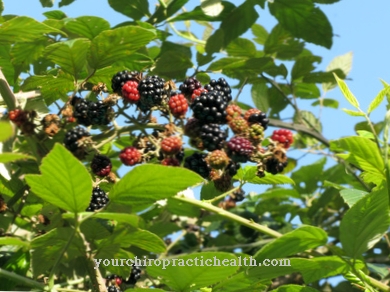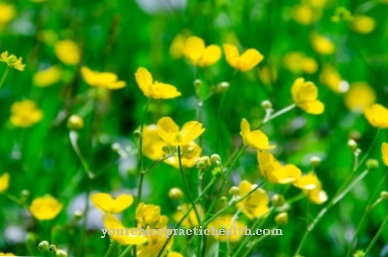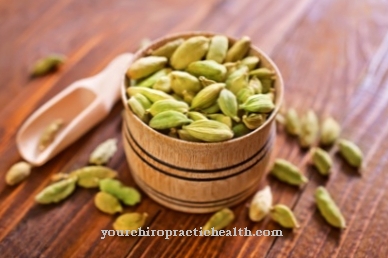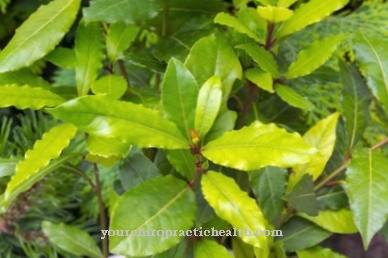In the yew it is a green conifer that can also be used as a medicinal plant. However, most of the ingredients are very toxic.
Occurrence and cultivation of the yew tree

The European yew is an evergreen conifer and reaches heights of between 2 and 15 meters. Depending on the site conditions, the yew can also grow as a shrub. It even occurs as a creeping shrub in the high mountains or on rock faces.
The trunk is equipped with a red-brown bark. The leaves of the tree are evergreen needles. The yew tree blooms in April and May. From August one or two seeds emerge from the flowers, which have a green-brown color. They are located in a red fruiting body that has a fleshy coating. The seeds are spread by birds.
Although the tree is called the European yew, its range extends beyond the European continent. Its habitat ranges from Europe to the Northwest African Atlas Mountains, Asia Minor and the Caucasus region to northern Iran. In Europe, the yew tree prefers to thrive in shady forests. It is also found as an ornamental shrub in parks or cemeteries. It prefers soils that are rich in lime and nutrients.
Effect & application
The ingredients of the European yew tree include biflavonoids, phenols, vitamin C, taxacins, taxin A and taxin B. Other ingredients are betuloside, diterpenes, baccatin III, paclitaxel and ginkgetin. Apart from the yew seed coat, all other parts of the tree are considered poisonous. The toxic substances cannot be removed even by drying or boiling.
The toxicity of tree parts such as seeds, needles, bark and wood varies from tree to tree. It also depends on the season. On the other hand, the red seed coat of the ripe fruits is non-toxic. These have a sweet taste and can be consumed raw. However, the poisonous seeds must never be swallowed, as they are toxic. The fruits are considered helpful against scurvy. Children should refrain from eating the fruit as there is a risk of swallowing the seeds.
The fresh twig tips of the yew tree are primarily used for medicinal purposes.The healing active ingredients include cyanogenic glycosides such as biflavonoids, taxiphylline, ginkgetin, sciadopitysin, baccatin III and diterpene alkaloids of the taxane type. For external use, a tincture made from the needles of the tree is used. It is used to treat skin parasites. Since the active ingredients of the common yew are suitable for the treatment of cancer, they are also used internally despite their toxicity.
However, self-treatment is not possible, so that the medicinal plant must always be used under the supervision of a doctor. In the Middle Ages, the yew also functioned as a therapeutic incense. By inhaling the smoke, cold symptoms such as coughing and runny nose or lung diseases should be alleviated.
Due to its toxicity, conventional medicine nowadays largely dispenses with the European yew. However, it has therapeutic uses for homeopathy. This produces the homeopathic remedy Taxus baccata from the yew branches. For this purpose, the agent is diluted so much that it cannot cause any damage. It is used, among other things, to treat gastrointestinal complaints and skin diseases.
Importance for health, treatment & prevention
In ancient times, the yew tree was first used as a means to poison people. The tree's poison was considered to be quick and effective. The Celts used yew sap for their arrow poisons. In addition, the yew tree should have magical effects and be able to conjure up or drive away spirits. In addition, wands were made from yew wood. Numerous cultures classified the yew tree as sacred.
In the Middle Ages the yew was also used as a medicinal plant. The Persian physician Avicenna was one of the first therapeutic users in 1021. The plant was initially used against rabies, snakebites, gallbladder problems and liver problems. In folk medicine, the European yew was used to treat heart problems, epilepsy, rheumatism, diphtheria, scabies or worm infestation.
It was given to women to help menstruate. A brew made from yew needles also served as an effective means of abortion. Due to the toxicity of the yew, the risk for the patients should not be underestimated. Since numerous non-toxic alternatives are now available, herbal medicine does not currently use the toxic plant.
The yew tree has been of interest to conventional medicine again since the 1990s because the partially synthetic isolation of the cell division-inhibiting substance paclitaxel was successful. This substance could previously only be isolated from the bark of the Pacific yew tree (Taxus brevifolia). The isolation took place from the taxane connections within the yew needles. Substances from the yew tree are used today against cancer diseases such as ovarian cancer, bronchial cancer and breast cancer.
However, since there is a risk of serious side effects, it is only used if all other forms of treatment fail. Homeopathy uses substances from the yew tree primarily to treat skin rashes and digestive problems. Other indications are heart disease, gout, rheumatism and liver disease.



























